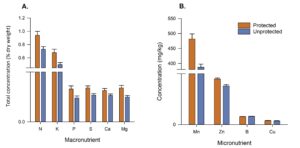Final report for GS18-194
Project Information
The rice water weevil, Lissorhoptrus oryzophilus Kuschel, is the most important insect pest of rice in the United States. This insect poses a global threat to rice production, having recently invaded rice-producing regions of Asia and Europe. Ideally, management of rice water weevil should incorporate combinations of control tactics. However, the current management program relies heavily on chemical control. To minimize the impact of insecticides on the environment while maintaining production levels, increased use of alternatives to chemical control is needed. Of the available alternative tactics, host-plant resistance may have the most potential to contribute to a more sustainable pest management program. In particular, traits that allow plants to mitigate the negative effects of herbivory will be investigated. Tolerance is a type of plant defense that allows crop plants to maintain yield in spite of herbivore injury. Susceptible rice genotypes generally suffer greater yield losses than tolerant genotypes when exposed to similar levels of injury.
This study assessed the level of tolerance in commonly grown rice cultivars in Louisiana under varying field conditions from 2017-2019 at the LSU Agcenter H. Rouse Caffey Rice Research Station in Crowley, Louisiana. The compatibility of plant tolerance with other non-chemical tactics such as early planting and delayed flooding was evaluated in 2019-2020. Moreover, tolerance-associated traits were examined to aid in the development of rice cultivars that are tolerant to weevil injury.
The ultimate goal of the proposed research is to improve the sustainability of rice production by developing a pest management program that will reduce reliance on chemical control, reduce production costs, and increase net income.
Objective 1: Compare yield losses due to rice water weevil injury in commonly grown rice cultivars in Louisiana under varying field conditions.
Objective 2: Assess the independent and interactive effects of rice cultivars and cultural control practices against rice water weevil.
Objective 3: Elucidate tolerance-related traits to root injury in rice.
Cooperators
- (Researcher)
Research
Objective 1: Compare yield losses due to rice water weevil injury in commonly grown rice cultivars in Louisiana under varying field conditions.
Field experiments were conducted from 2017–2019 at the LSU AgCenter, H. Rouse Caffey Rice Research Station in Crowley, LA. Rice cultivars used in this study were selected from commonly grown inbred rice cultivars in Louisiana (Catahoula, Cheniere, CL111, CL151, Cocodrie, Jazzman-2, Jupiter, and Mermentau). Seeds were drill-planted in plots measuring 5.5 m in length with seven rows spaced 18 cm apart at a seeding rate of 67 kg ha-1. Pest infestation levels were manipulated by treating seeds with chlorantraniliprole (Dermacor X-100, Corteva Agriscience). Three rates of seed treatment were employed – 0 (nontreated), 7.9 (low rate), and 78.5 (label rate) g a.i. ha-1 –to achieve high, moderate, and low pest infestation levels, respectively. Plots were laid out according to a split-plot randomized block design with four blocks. Each block contained a cultivar (whole-plot) × insecticide rate (split-plot) factorial arrangement. Fields were surface irrigated as needed to facilitate plant emergence and stand establishment. Permanent flood was applied 4-6 weeks after planting, depending on the year. Field plots were maintained by following the water management, weed control, fertilization, and other production practices recommended for Louisiana drill-seeded rice.
Numbers of immature rice water weevil (larvae and pupae) were evaluated 3-4 weeks after the permanent flood. Root-soil core samples, with each sample containing a minimum of one rice plant with intact roots, were taken from each plot using a metal corer (9.2 cm diameter, 7.6 cm deep). Core sampling was conducted twice in 2017 (four cores per plot, 768 samples total), twice in 2018 (three cores per plot, 576 samples total), and once in 2019 (three cores per plot, 288 samples total). Individual core samples were processed by washing the soil from the roots in 40-mesh screen sieve buckets that were then placed in basins of a saturated salt solution. Rice water weevil larvae were counted as they floated to the surface and pupae were counted by inspecting bottoms of sieve buckets. The numbers of larvae and pupae in the 3–4 core samples from each plot were averaged prior to analysis.
At 100% heading, whiteheads resulting from stemborer infestations were visually assessed in each plot. The total number of whiteheads in each plot was recorded and converted to whiteheads per m2. Whiteheads were collected and were brought back to the laboratory to retrieve and identify the stemborer species.
Entire plots were harvested using a small-plot combine at grain maturity. Grain weights were adjusted to 12% moisture and converted to kg ha-1. Yield losses (%) were calculated for each cultivar in each block, using the formula: % yield losses = [(yieldprotected – yieldinfested)/yieldprotected] × 100, where ‘protected yields’ were yields from plots treated with the label rate (78.5 g a.i. ha-1) and ‘infested yields’ were yields from nontreated plots or plots treated with the low rate (7.9 g a.i. ha-1) of chlorantraniliprole for a given block.
Rice water weevil density, whitehead incidence, and yield loss data were analyzed using generalized linear mixed models (PROC GLIMMIX). All analyses were carried out in SAS version 9.4.
Objective 2: Assess the independent and interactive effects of rice cultivars and cultural control practices against rice water weevil.
Field experiments were conducted from 2019–2020 at the LSU AgCenter H. Rouse Caffey Rice Research Station in Crowley, LA. In each year, two separate trials were established – one planted early and the other late relative to recommended planting dates in southwest Louisiana. For each trial, field plots were laid out according to a split-split-plot randomized block design with four blocks. Each block contained a flood timing (whole-plot) × cultivar (sub-plot) × insecticidal seed treatment (sub-sub plot) field plot arrangement. Rice cultivars used in this study are commonly grown in Louisiana (Cocodrie, Mermentau, Jupiter, and Jazzman-2). Seeds were drill-planted at a seeding rate of 67 kg ha-1 in plots measuring 5.5 m in length with seven rows spaced 18 cm apart. Before planting, each cultivar was either treated or not treated with chlorantraniliprole seed treatment (Dermacor® X-100, Corteva Agriscience) at a rate of 78.5 g a.i. ha-1. After planting, fields were surface irrigated as needed to facilitate plant emergence and stand establishment. When the rice plants reached the five-leaf to early tillering developmental stage, the permanent flood was applied to plots assigned to the normal flood timing treatment, whereas permanent flood was applied two weeks later to plots assigned to delayed flood timing. Field plots were maintained following the standard recommendations for weed control and fertilization for drill-planted rice in Louisiana. Weevil density, whitehead incidence, and yield loss data were collected similar to Objective 1.
Rice water weevil density, whitehead incidence, and yield loss data were analyzed using generalized linear mixed models (PROC GLIMMIX). All analyses were carried out in SAS
Objective 3: Elucidate tolerance-related traits to root injury in rice.
Field experiments were conducted at the LSU AgCenter H. Rouse Caffey Rice Research Station in Crowley, Louisiana in 2020. Two separate trials were established – one planted early and the other late relative to recommended planting dates in southwest Louisiana. For each trial, field plots were laid out following a randomized block design with six blocks. Each block contained a cultivar (hybrid and inbred) × insecticidal seed treatment (treated and nontreated) factorial arrangement. Seeds of the hybrid cultivar ‘RT7521’ (RiceTec Inc.) and inbred ‘CL151’ were drill-planted at a seeding rate of 28 kg ha-1 and 67 kg ha-1, respectively, in plots measuring 5.5 m in length with seven rows spaced 18 cm apart. Prior to planting, seeds of each cultivar were either treated or not with a standard rate (78.5 g a.i. ha-1) of chlorantraniliprole seed treatment (Dermacor X-100, Corteva Agriscience). Treated and nontreated plots of the same cultivar were placed side-by-side to reduce variation in weevil infestations and yields. After planting, fields were surface irrigated as necessary to facilitate plant emergence and growth. Permanent flood was established at 4–5 weeks after planting when the rice plants reached the early-tillering developmental stage. Field plots were maintained following the standard recommendations for fertilization and weed control for drill-seeded rice in Louisiana.
Immature rice water weevil (larvae and pupae) densities were evaluated similarly to Objectives 1 and 2. Core sampling was conducted five times (14, 22, 30, 36, and 42 days after permanent flood in the early-planted trial and 19, 26, 33, 40, and 48 days after permanent flood in the late-planted trial), and two core samples were taken from each plot per sampling point. To determine plant biomass, roots and shoots were separated from each sample and dried in an oven (60°C for one week). Dry weights of roots and shoots were recorded using a digital weighing scale.
Concentrations of nutrients in plant shoots were evaluated in both early- and late-planted trials. Dried plant materials from core samples described previously were sent to LSU AgCenter’s Soil Testing and Plant Analysis Laboratory (Louisiana State University, Baton Rouge, LA). Moreover, rice shoots were collected at 10, 20, and 30 days after the permanent flood in the early-planted trial for the quantification of plant hormones. For each time point, two plant samples (combination of leaves and stems) were taken from each plot and immediately flash-frozen in liquid nitrogen. Samples were sent to Creative Proteomics (Shirley, NY) for quantitative measurement of abscisic acid (ABA), salicylic acid (SA), jasmonic acid (JA), jasmonic acid-isoleucine (JA-Ile), 12-oxo-phytodienoic acid (OPDA), and indoleacetic acid (IAA).
At grain maturity, entire plots were harvested using a small-plot combine. Grain weights were adjusted to 12% moisture. Percentage yield loss was calculated for each cultivar using a formula similar to that in Objectives 1 and 2.
Data were analyzed separately by planting date. All analyses were performed in SAS version 9.4. Rice water weevil density, plant biomass (roots and shoots), nutrient concentration, plant hormone, and yield loss data were analyzed using generalized linear mixed models (PROC GLIMMIX).
Objective 1: Compare yield losses due to rice water weevil injury in commonly grown rice cultivars in Louisiana under varying field conditions.
Weevil densities varied across years but remained high (8–22 immature rice water weevil per core). Reductions in weevil densities by 85.5% were observed in plots treated with the label rate of chlorantraniliprole and reductions of 44.4% were observed in plots treated with the low rate of chlorantraniliprole relative to nontreated plots, across cultivars and years. The popular medium-grain rice cultivar ‘Jupiter’ supported the highest numbers of weevils which suggest that this cultivar is highly susceptible to weevil, whereas weevil densities on remaining cultivars were intermediate. In 2017, stemborer injury was caused by a combination of sugarcane borer and Mexican rice borer, while in 2018 and 2019, stemborer injury was caused by mostly Mexican rice borer. Low stemborer injury was observed in ‘Cheniere’ and ‘Jazzman-2’ which suggest that these cultivars exhibit some levels of resistance to stemborer. High stemborer injury was observed in ‘CL151’, ‘Cocodrie’, and “Mermentau’. The combination of weevils and stemborers negatively affected rice yields with yield losses ranging from 10.4–17.9% among cultivars. Differences in yield losses among cultivars were minimal, which suggests that, in general, these cultivars do not differ in levels of tolerance. However, when yield loss × weevil relationships were considered, results revealed that ‘Cocodrie’ appeared to be more tolerant than ‘Cheniere’ indicated by significantly lower yield losses in ‘Cocodrie’ relative to ‘Cheniere’.
More information on this objective can be found at: https://onlinelibrary.wiley.com/doi/10.1111/eea.13054?af=R.
Objective 2: Assess the independent and interactive effects of rice cultivars and cultural control practices against rice water weevil.
Insecticidal seed treatment reduced weevil densities and stemborer injury by 70–84% and 87–94%, respectively, across planting dates, years, cultivars, and flood timings. The medium-grain rice cultivar ‘Jupiter' consistently supported the highest numbers of immature weevils, whereas low levels of stemborer injury were observed in ‘Jazzman-2'. Results of rice cultivar susceptibility to weevils and stemborer were consistent with Objective 1. Weevil densities were 72% and 20% lower in plots subjected to delayed flood compared to normal flood timing in the 2019 and 2020 late-planted trials, respectively. Reductions of 79% and 93% in stemborer injury in the 2019 early- and late-planted trials, respectively, were observed in delayed flooded plots. Weevil and stemborer infestations negatively affected rice yields, with losses among cultivars ranging from 14 to 49%. Yield losses were generally lower in plots subjected to delayed flood compared to normal flood timing but the difference was only significant in the 2020 late-planted trial. Our data suggest that the combination of cultivar resistance and delayed flooding can serve as a valuable component of an integrated pest management program for both rice water weevil and stemborers.
More information on this objective can be found at: https://www.frontiersin.org/articles/10.3389/fagro.2021.754673/full.
Objective 3: Elucidate tolerance-related traits to root injury in rice.
Weevil densities were influenced by cultivar, insecticidal seed treatment, and time in both the early- and late-planted trials. The hybrid cultivar supported 9 and 19% more weevils than the inbred cultivar in early- and late-planted trials, respectively (Figs. 1A, D). Seed treatment reduced weevil densities by 71 and 72% in early- and late-planted trials, respectively (Figs. 1B, E). The numbers of weevils varied across sampling times with peak densities occurring approximately four weeks after the permanent flood were established in both early- and late-planted trials (Figs. 1C, F).
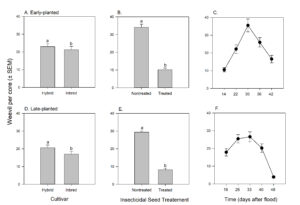
Shoot and root biomass were influenced by cultivar, insecticidal seed treatment, and time. Root dry weights were generally higher in the hybrid compared to the inbred cultivar across sampling times in both early- and late-planted trials. In particular, root dry weights at 36 and 40 days after flood were 44 and 51% higher in the hybrid than the inbred cultivar in the early- and late-plated trials, respectively (Figs. 2A, C). Shoot dry weights were higher in the hybrid compared to inbred cultivar in the early-planted trial only (Fig. 2B). High weevil infestations in nontreated plots reduced shoot biomass by 16 and 29% compared to treated plots in the early- and late-planted trials, respectively (Figs. 2B, D). Both root and shoot dry weights increased proportionately with time (days after flood establishment.
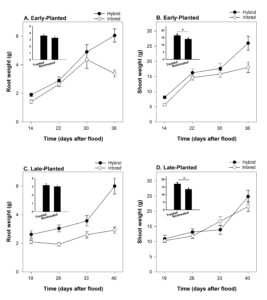
The concentrations of nutrients in rice shoots were variably influenced by cultivar, insecticidal seed treatments, time in both early- and late-planted trials. In the early-planted trial, concentrations of macronutrients N, K, and S and micronutrients Mn and Zn were significantly higher in the hybrid compared to the inbred cultivar (Fig. 3). Weevil feeding negatively affected both macro and micronutrients in rice plants. The concentrations of macronutrients N, K, P, S, and Mg, and micronutrients Mn, Zn, and Cu were reduced in nontreated compared to treated plants (Fig. 4). The majority of plant nutrients decreased across sampling time. Chronic feeding of weevil larvae reduced concentrations of nutrients across time. In particular, the concentrations of P, S, Ca, and Mg, Mn, Zn, B, and Cu were lower in nontreated plants compared to treated plants across time (data not shown). In the late-planted trial, the concentrations of Fe and Mn were higher in the inbred cultivar while the concentrations of K, S, and Mo were higher in the hybrid cultivar (data not shown). The concentrations of macronutrients K, P, Ca, and Mg and micronutrients Mn, Zn, and Cu were reduced in nontreated compared to treated plants (data not shown). Chronic feeding of weevil larvae in the late-planted trial only affected Zn concentrations in rice shoots.
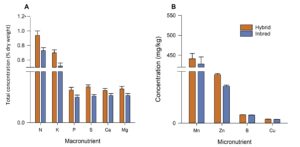
Production of JA and OPDA in rice shoots was influenced by cultivar. The concentrations of JA and OPDA were 23 and 20% higher, respectively, in the hybrid cultivar compared to the inbred cultivar across sampling time (Figs. 5A, C). Weevil infestations increased the production of OPDA. The concentration of OPDA was 11% higher in nontreated plants compared to treated plants (Fig. 5C, embedded graph). An increase in the production of JA, JA-Ile, OPDA, and JA was observed at 10 d after flood and the concentrations of these plant hormones subsequently decreased at 20 and 30 d after flood (Figs. 5A, B, C, D).
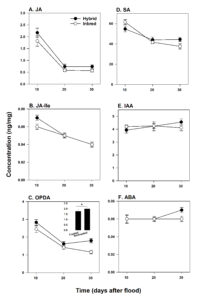
Yield losses due to rice water weevil infestations ranged from 8–35% across planting dates and cultivars. Percent yield losses were affected by cultivar in the late-planted trial but not in the early-planted trial. Inbred cultivar exhibited 27% greater yield loss than hybrid cultivar in the late-planted trial.
The results from Objective 3 demonstrated that root herbivory by weevil larvae negatively affected plant nutrient uptake of macro and micronutrients essential for growth and development. The reductions in nutrient uptake in weevil-infested plants may be the primary cause for subsequent reductions in plant growth and yields. The hybrid cultivar in this study, as previously reported, was more tolerant to weevil infestations than the inbred cultivar. This may be due to higher root and shoot biomass accumulation and yield potential in the hybrid compared to the inbred cultivars.
Educational & Outreach Activities
Participation Summary:
Presentations
- Villegas, J.M., E. Wilson, and M.J. Stout. 2021. Delayed flood timing and rice cultivar influence infestations of rice water weevil and Mexican rice borer in drill-seeded rice. Entomological Society of America Annual Meeting, Denver, Colorado, October 31-November 4, Talk.
- Wilson, B.E. and J.M. Villegas. 2021. Rice entomology. H. Rouse Caffey Rice Research Station Annual Field Day, June 30, Invited Speaker.
- Villegas, J.M., B.E. Wilson, and M.J. Stout. 2020. Tolerance to insect pests among commonly grown rice cultivars in Louisiana. 38thRice Technical Working Group Meeting, Orange Beach, Alabama, February 24 – 27, Talk.
- Villegas, J.M., B.E. Wilson, and M.J. Stout. 2019. Utilizing plant tolerance as an alternative management tactic against insect pests of rice (Oryza sativa L). Entomological Society of America Annual Meeting, St. Louis, Missouri, November 17 – 20, Poster.
- Villegas, J.M., B.E. Wilson, and M.J. Stout. 2019. Tolerance of commonly grown cultivars in Louisiana to rice water weevil infestations. 10th Annual LSU Entomology Department Graduate Student Symposium, Baton Rouge, Louisiana, October 22, Ph.D. Poster Presentation.
- Villegas, J.M. and B.E. Wilson. 2019. Rice insect pest management. Acadia Parish Rice and Soybean Producers Meeting, January 3, Invited Speaker.
- Villegas, J.M. and M.J. Stout. 2018. Evaluating tolerance traits to root injury in drill-seeded rice. 92nd Annual Meeting of the Southeastern Branch of the Entomological Society of America, Orlando, Florida, March 4 – 7, Talk.
- Villegas, J.M. and M.J. Stout. 2018. Tolerance to rice water weevil injury in rice. 37thRice Technical Working Group Meeting, Long Beach, California, February 19 – 22, Talk.
Refereed Publications
- Villegas, J.M., B.E. Wilson, and M.J. Stout. 2021. Integration of host plant resistance and cultural tactics for management of root- and stem-feeding insect pests in rice. Frontiers in Agronomy 3: 754673; doi:10.3389/fagro.2021.754673
- Villegas, J.M., B.E. Wilson, and M.J. Stout. 2021. Assessment of tolerance and resistance of inbred rice cultivars to combined infestations of rice water weevil and stemborers. Entomologia Experimentalis et Applicata 169: 629–639. doi:10.1111/eea.13054
- Villegas, J.M., B.E. Wilson, and M.J. Stout. 2022. Effects of chronic root herbivory by the rice water weevil on endogenous phytohormones and nutrient concentrations in rice plants. (manuscript in preparation).
Project Outcomes
Current management programs for rice water weevil rely heavily on synthetic insecticides. There is a need for a more holistic approach to insect pest management in rice production. Results from the experiments presented herein suggest that the integration of tolerant cultivars into insect pest management programs is a potentially valuable strategy, particularly when combined with other control tactics (e.g. delayed flood timing). The use of tolerance cultivars may be sufficient to reduce yield losses in the absence of insecticide where weevil pressure is low or in organic rice. Plant tolerance is also a suitable alternative approach in situations where insecticide use is not desirable. Additionally, plant resistance may serve as a valuable component of an integrated pest management program for stemborers, especially if stemborer incidence continues to increase in Louisiana rice. Future studies should investigate in-depth the plant traits associated with tolerance to facilitate the development of tolerant rice cultivars.
In an ideal world, the management of rice insect pests should incorporate combinations of control strategies, but current management programs rely heavily on chemical control. During this project, I’ve learned that there are potential alternative approaches to chemical control. However, these strategies require more effort to understand the complexity of the interactions among crops, insects, and the environment. Perhaps this is the reason why some of the sustainable approaches are harder to implement. As long as researchers and producers are willing to try innovative ways in managing farms, the future of sustainable agriculture is bright.
